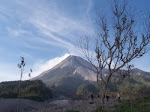Most areas susceptible to landslides are densely populated, due to the presence of fertile soil and good water resources which often contribute to slope instability. Despite efforts to establish slope protection zones by restricting development and settlement, efforts to carry out a relocation program have been difficult due to socio-economic constraints. Thus, a landslide early warning system is urgently needed to guarantee the safety of communities in such areas.
Dr. Dwikorita Karnawati from the Geological Engineering Department of the Gadjah Mada University-Indonesia (GED-GMU) led the team seeking to install early warning systems in several pilot areas, including Banjarnegara Regency and Karanganyar Regency in Central Java, as well as Situbondo Regency East Java. The teams were multi-disciplinary, with experts such as geologists from GED-GMU (Mr. Ign. Sudarno and Mr. Fajar Tri Prasetya), a civil engineer from GMU (Dr. Teuku Faisal Fathani), A GMU sociologist (Mr. Suharto), accompanied by Dr. Paul Burton from East Anglia University-UK and several local people.
To be effective, a landslide early warning system should be inexpensive, simple to operate and installed in the most appropriate sites. Therefore such systems must be based on the incorporation of sound technological and sociological approaches.
Most of the landslides occurring in the susceptible areas are debris slides which usually are initiated by extension cracks. Thus, the extensometer is considered the most appropriate monitoring and warning equipment, which should be placed by using extension wires across the extension cracks.
To guarantee such a comprehensive monitoring system, five sets of manual extensometers which cover the area of about 75 to 100 hectares were installed in the selected sites. Those extensometers were designed to stretch automatically across the cracks in response to the enlargement of the cracks caused by slope movement. The crack-extension is the indicator of the slope movement that proceeds a landslide. Accordingly, when the extensometer's string is stretched up to 4 cm in length (this length was defined based on previous empirical investigations at similar susceptible landslide areas), the connected alarm sounds an early warning to the community, allowing time for escape.
One extensometer was designed not only to monitor the lateral movement at the slope surface, but also the vertical deformation, as well as the rotational direction of the sliding. Thus, within one extensometer, three different directions of movement can be monitored by utilizing simple but low cost materials.
All of the monitoring system was connected with the siren alarm, which can be heard by the community up to a distance of 500 m. The first community group hearing the alarm then should hit the ‘thong-thong’ (local warning system made from wood or bamboo) to transfer the warning to the other community groups living in the distance beyond 500 m. This five extensometer installment needs to be incorporated with one rain gauge. The rain gauge was installed in the top of the slope to record the rainfall, because landslides in the area mostly occurr as the result of rain. The alarm was also set to start if the accumulative rain infiltration reaches 100 mm. This critical amount of rain infiltration was set based on previous research conducted by Karnawati (1996) and Su Su Ky (2007).
Because of the simplicity of its design, the equipment can be constructed in local home workshops. Thus, the three-directional extensometer will not only potentially reduce landslide risk to human life, but also stimulate the local economy.
 Schematic performance of extensometer installed across the crack (Japan Landslide Society, 1996).
Schematic performance of extensometer installed across the crack (Japan Landslide Society, 1996). Rain gauge developed by T.F. Fathani & D.Karnawati,Gadjah Mada University, 2007 (Paten No. P00200800299). Extensometer developed by T.F. Fathani & D.Karnawati, Gadjah Mada University, 2007 (Paten No. P0020080030).
Rain gauge developed by T.F. Fathani & D.Karnawati,Gadjah Mada University, 2007 (Paten No. P00200800299). Extensometer developed by T.F. Fathani & D.Karnawati, Gadjah Mada University, 2007 (Paten No. P0020080030). Evacuation drill at Kalitelaga Village, Banjarnegara District, Central Java Province, conducted on September 2007.
Evacuation drill at Kalitelaga Village, Banjarnegara District, Central Java Province, conducted on September 2007.The Faculty of Engineering, Gadjah Mada University and the Indonesian Ministry of Development for Disadvantaged Regions reported that the early warning system equipment has worked properly in Kalitelaga District, at Banjarnegara Regency, Central Java. In November 2008, the extensometer alarm came on following the early warning issued by the rain gauge, giving the community enough time to move to safer ground. Several houses were damaged in the landslide and the access road to the village was buried. Fortunately, 35 families living were saved.
The challenge is to implement this early warning system (EWS) in areas where no landslide has yet occurred. Some resistance from the community, especially relating to setting aside land for the equipment, may be the most difficult problem to tackle. Encouraging the community to maintain the operation of the equipment is another challenge.
The government of Indonesia is considering other pilot EWS programs in Java and Sumatra.
Data courtesy of: Karnawati, et al, based on the Proceedings of the first World Landslide Forum, Tokyo , November 2008, pp. 305 - 308.





0 comments:
Post a Comment